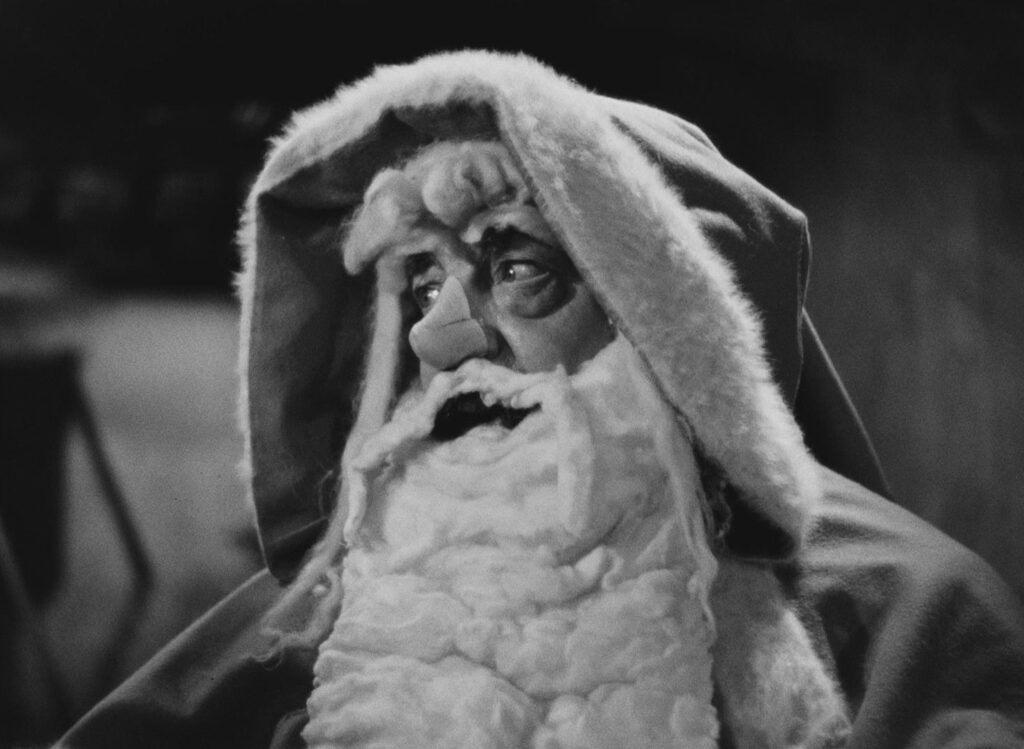
The Assassination of Père Noël
1941, directed by Christian-Jaque
Woven through the diverse plot threads of The Assassination of Père Noël is the curious character of La mère Michel (Old Lady Michelle) who keeps popping up to look for her lost cat Mistou. After she accuses the pharmacist Ricomet of murder, suspicion falls on her because she protests too strongly against searching her house for the stolen diamond. But it’s not the diamond she’s hiding, it’s the stuffed body of Mistou. The discovery is a shock, but it confirms what the whole town suspected, that she’s an extreme case of the archetypal “crazy cat lady”.
As it turns out though, she was right about Ricomet, so it may not be fair to question her sanity. It seems she’s just a lonely woman looking for human contact in the absence of her dead cat. Desperate for kindness, she’s rejected everywhere – by the schoolchildren, in the church, at the inn, in the town hall. A policeman defends her from the children’s mockery, but then he too turns away from her. She knows all along that Mistou is dead, yet she keeps hoping for sympathy from her fellow villagers.
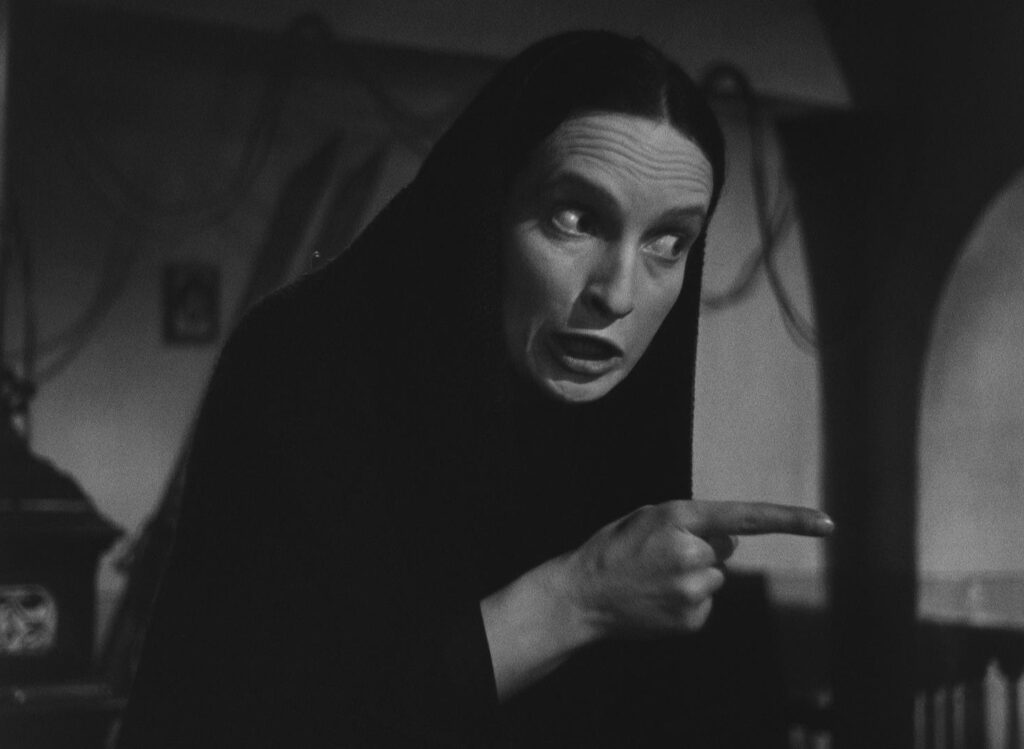
La mère Michel is not an instrumental figure in the plot. Although the murder mystery turns its spotlight on her for a moment, that proves to be a dead end. Her real role is to clarify the title, which of course speaks to the film’s purpose. If we understand the assassination of Santa Claus to represent the killing off of generosity, we start to get a picture of a society where charity and goodness are being replaced by fear and mistrust. Bearing in mind that it’s 1941, more than a year into the Nazi occupation, the alpine village looks like a microcosm of France.
Like so many French films made during the Occupation, the allegory runs deep. A current of fantasy makes it easy to hang covert allusions onto characters, events, words, and situations. German censors, not being attuned to French culture, would miss most of the references. The often bizarre plots of this era fit conveniently into a tradition of surrealism in French film, giving filmmakers plausible deniability in case the Nazis suspected any secret messages.
Although Nazi authorities monitored film production closely during the Occupation, several key actors, writers, and directors were leftists and therefore sympathetic to the Resistance or active participants in it. Harry Baur, who plays Cornusse and Père Noël, was tortured by the Gestapo after trying to protect his Jewish wife and was killed under mysterious circumstances less than two years after the film’s release. Most of the subversive allegorical films of the Occupation came out in 1942 and 1943; the early ones tended to be hopeful, quietly rallying viewers against the Nazis, but by late 1943 as hope started fading they turned pessimistic. The Assassination of Père Noël was released in October 1941, making it probably the first of these allegories. Its ulterior purpose is not yet a rallying cry so much as a calming voice of reason, urging people to resist the forces that were tearing French society apart and taking advantage of divisions in an already polarized country. Like a few later allegories, including Goupi Mains Rouges and Lumière d’été, the film contains few direct references to Germany or Nazis, focusing instead on French society itself.
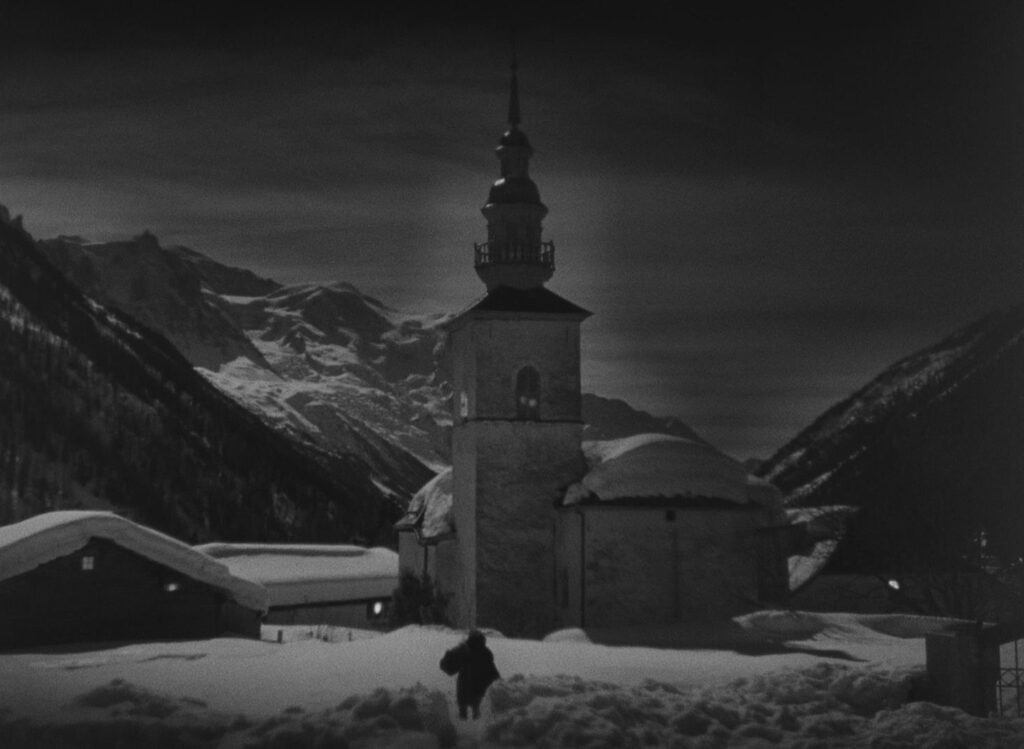
The location in the Savoy Alps places the movie squarely within Vichy France, a painful reminder to Parisian audiences that the country had been torn in two. The mountain village would be near the borders of neutral Switzerland and fascist Italy, avoiding direct contact with Germany but nevertheless placing the action symbolically on the eastern edge of France, close to the historical vanguard of its defense. The robbery that sets the plot in motion is a collaboration between a native and an outsider, just as the Occupation itself was a crime perpetrated by outsiders with the collaboration of far too many French citizens. The gendarmes, who spend much of the second half on the village outskirts sealing off the murderer’s escape routes, and who eventually come in from the west to solve the crime, are like the Allied armies fighting in the north, south, and east before rescuing France from the west. Of course D-Day hadn’t happened yet in 1941, but it shouldn’t have been hard to foresee.
Cornusse’s innocent daughter Catherine, prone to slumber and waiting for a swordsman to come on horseback and defeat her enemies, is the dormant spirit of France, hoping for the war to end. Like the French people getting by on reduced sustenance, she hasn’t been eating, and at the Baron’s castle she’s happy to find bread and water. The Baron must represent some form of the old order that’s been missing from France for ten years, since the start of the Great Depression in 1931. Ten years is also the amount of time the Baron’s been away, and the importance of 1931 is reinforced by the number “1361” inscribed prominently on the Baron’s gate. There’s no birth, death, coronation, war, or other event in the year 1361 that would have any obvious relevance, but when the number is flipped upside-down it becomes “1931”, only with the “3” reversed. Roland was probably the safest possible name for a defender of France, as it comes from a knight of the Frankish king Charlemagne, a figure so far back in history that both France and Germany claim him as a national hero. Later allegories like The Hand of the Devil and Lumière d’été also use the name Roland for similar reasons.
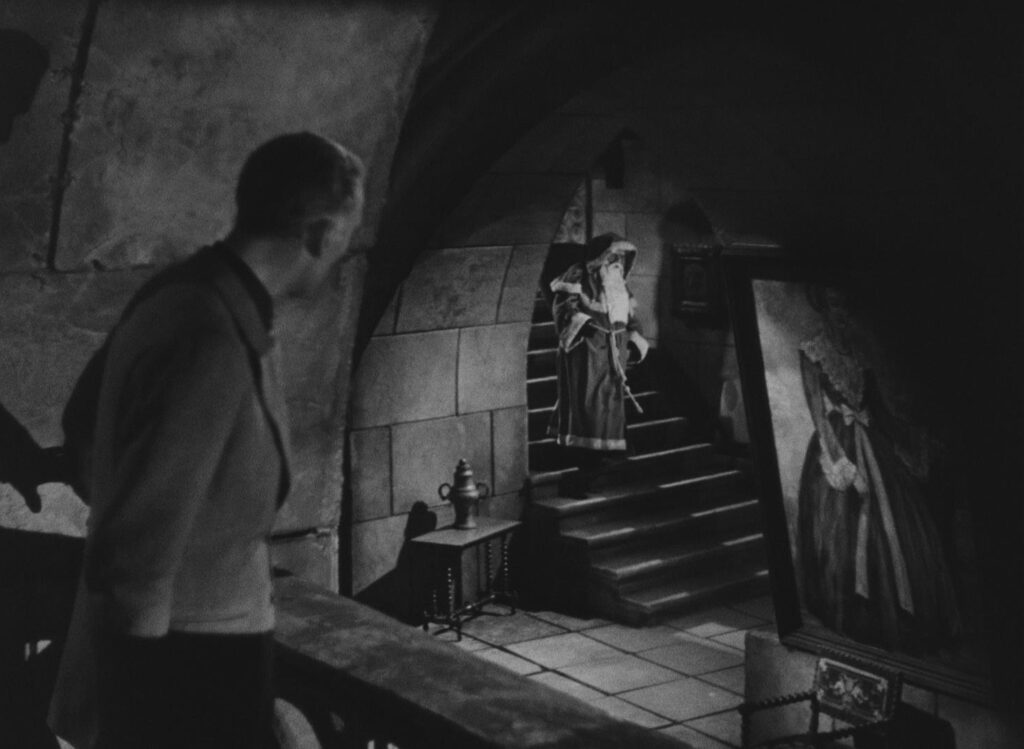
The Baron’s rival for Catherine is the schoolteacher Léon, a feckless intellectual whose courage is misdirected at accusing the wrong people – opening La mère Michel’s forbidden cabinet or pulling the glove off the Baron’s hand. France has long given a prominent place to its intellectuals and artists, but the films of the Occupation (like Lumière d’été) often portrayed cultural figures along with the military as weak and useless against German tyranny. In any case, no one expected them to save France.
Linking all these characters is the story of a double crime: the murder of a man dressed as Père Noël, and the theft of a large diamond ring worth over 300,000 francs that motivates the murder. Both Père Noël and the ring are associated with Saint Nicholas, the spirit of Christmas generosity, so both crimes represent the annihilation of kindness that can afflict a society under attack by a foreign enemy. As a treasure held in the church, the ring would have been genuine material security, not just a mere symbol to the villagers. In the real world kindness too is a form of security, holding people together and protecting them. The film warns the French people not to lose what makes them French – the spirit of goodness that resides in the ideals of Liberty, Equality, and Fraternity. The placement of the diamond at the nativity scene, and later inside the globe, dignifies it and reinforces its importance.
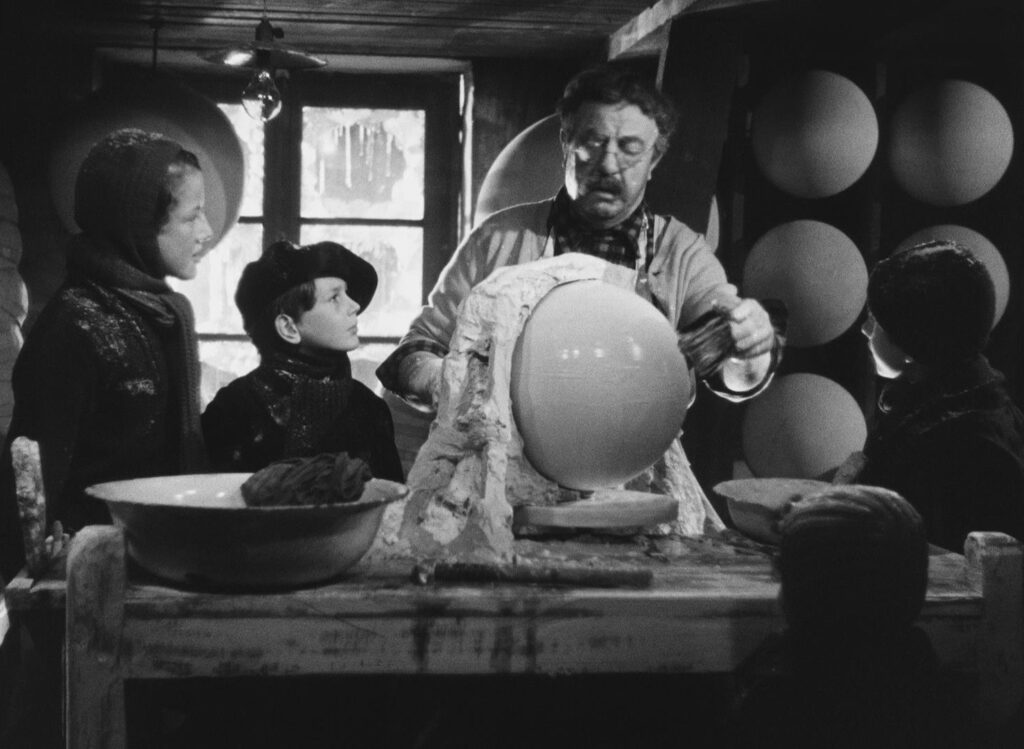
The diamond ring is one of many circles in The Assassination of Père Noël. All the circles and spheres seem to represent a unified and well ordered society. Inside the various houses, at the inn, and in the town hall people come together around circular tables. The globes are circular, as are the clocks which appear so frequently, and Père Noël’s basket. The villagers celebrate the holiday by dancing in circles, but the disruptive schoolteacher interrupts Christmas mass by marching his boys in a line outside the church – the opposite of social order, and a formation that would remind audiences of invading armies.
After the robber’s first attempt there’s a moment of comedy with a serious message about aiding the Resistance. When the constable calls the mayor from the inn to report the crime, the information he relays is supposed to be secret lest the perpetrator be put on his guard. However the constable’s voice carries loudly through the phone booth, and the villagers mock his inability to hold a secret. The scene is a warning to anyone holding delicate information about anti-Nazi activities.
While The Assassination of Père Noël mourns the loss of civility that’s ravaging the social order of France, it’s not yet ready to concede the more conservative elements of French society as lost causes. Many of the later pro-Resistance films took sides squarely with the left, but here we still have an aristocrat representing French ideals and the Catholic church as a valuable and cohesive force. The anti-clerical Léon comes off foolish and unsympathetic, and the Baron’s right hand – with its possible political symbolism – proves not to be as corrupt as everyone thinks. This hardly means the film aligns with conservative politics and culture, but its message, probably for the last time during the Occupation, speaks to a hope for national unity.
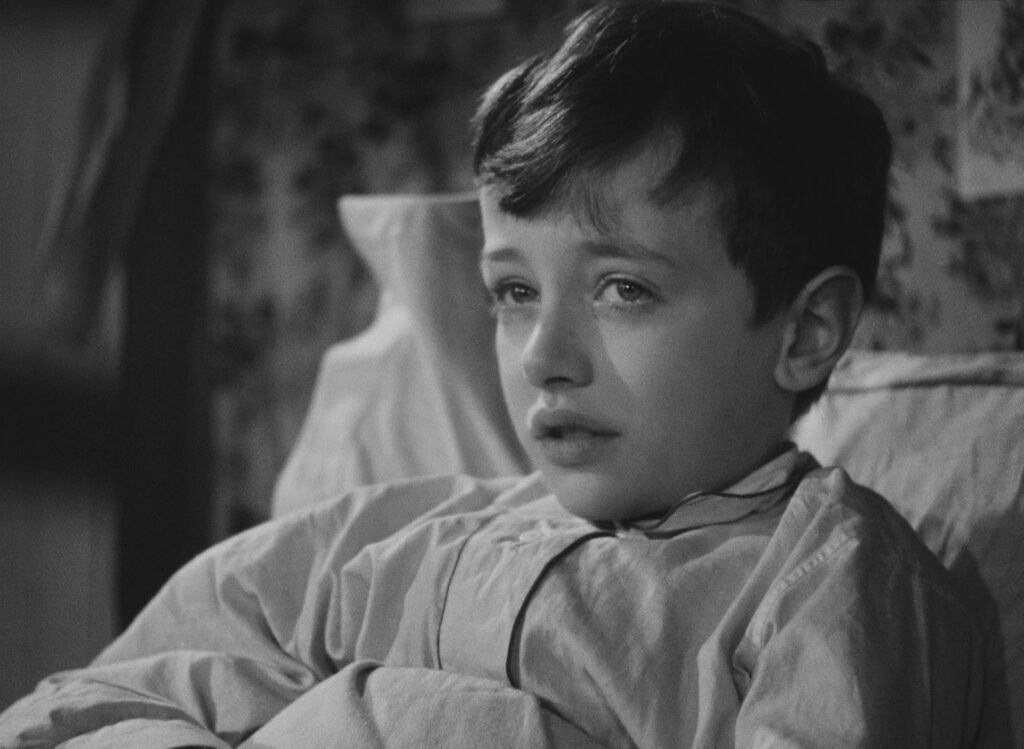
Of all the film’s hopeful images of shared national values, the most potent plays its part at the end. Amid all the strange events in the village, one character remains fixed in place, a sick young boy named Christian who is unable to walk. Like Père Noël and the diamond, his name embodies the spirit of goodness that the Nazi occupation threatens to destroy. Christian gets a small trumpet for Christmas, but he throws it down and breaks it. What he earnestly wants from Santa is a globe. A trumpet is a sign of the apocalypse, but a true Christian spirit longs not for the end of the world but for spiritual possession of the whole Earth. At the end his wish is granted, and Christian is resuscitated because, as Père Noël tells him, he was willing to give up his own life for what was most valuable. Under the horrors of the Nazi occupation, this film urged the French people to carry on that same spirit of charitable sacrifice for their country.
CONNECTIONS:
The Cabinet of Dr. Caligari – Series of mysterious crimes in a village; love triangle; creature kept in a cabinet
The Hand of the Devil – Name “Roland” used in an allegory for its dual French & German origin
Lumière d’été – Name “Roland” used in an allegory for its dual French & German origin